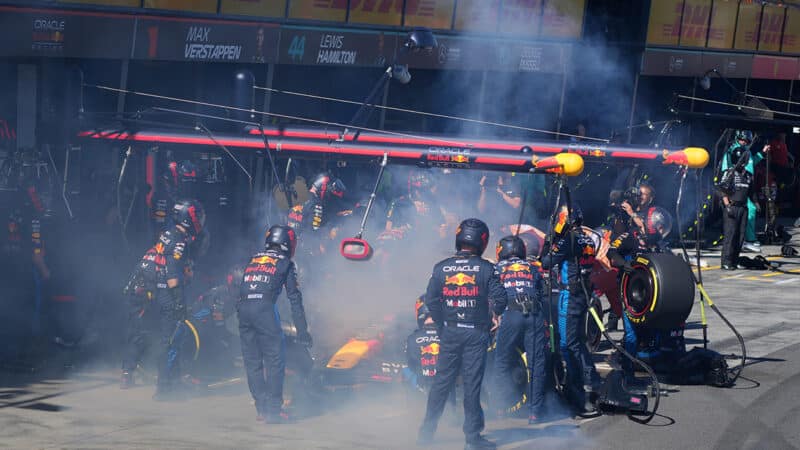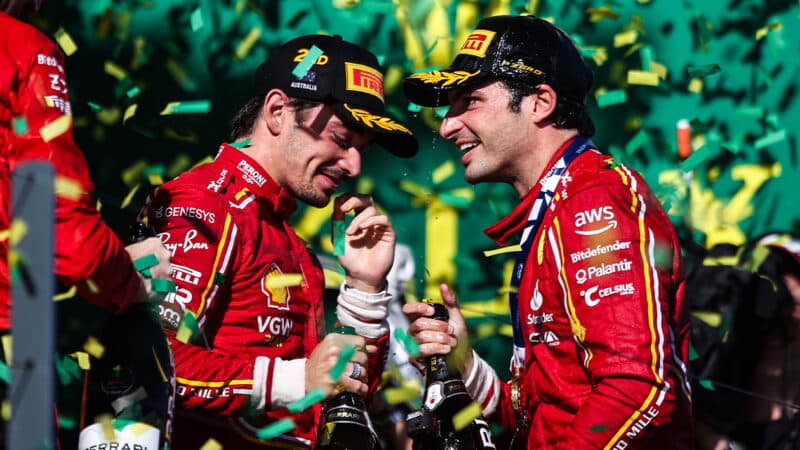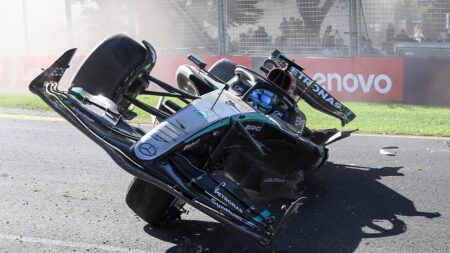Even before Verstappen trailed his RB20 into the pits with its right-rear brakes on fire at the end of the second lap (the outcome of a suspected preparation error), Sainz and Ferrari had looked stronger than at any point in the season to date. Red Bull had suffered a messy Friday, with Verstappen damaging the car over the Turn 10 kerbs, restricting his running time. The car was not as well balanced as usual, in stark contrast to the Ferrari which was quickly into its sweet spot. Even as the Red Bull came together on Saturday, it was not conclusively faster. Verstappen took an impressive pole, but had Sainz not suffered a big snap of oversteer in seventh gear through Turns 9-10, it would likely have been him. He’d got a better handle on the tricky demands of the track on the soft tyre than Leclerc and he was Ferrari’s cutting edge despite his very delicate state as he recovered from his recent operation.
Verstappen had 1sec on Sainz at the end of the opening lap, but Carlos was already beginning to claw that back as he ran down through the DRS zone between Turns 1 and 3 (the feature now enabled after the first lap). He had the sense that he was going to be able to race Verstappen. That became a certainty as he witnessed Max get very crossed up through the exit of Turn 3 and fought desperately for control. That sticking caliper was having a handbrake effect on the car’s stability. As Verstappen was slow out of there, Sainz’s better momentum plus DRS in the long kinking run between Turns 6-9 allowed him to sweep past for the lead. To the great approval of the crowd.

Smoke and extinguishant surround Verstappen’s Red Bull in the Melbourne pitlane
Scott Barbour/AFP via Getty Images
With Verstappen out a few corners later, Sainz had a comfortable margin over Lando Norris’s McLaren – and over everyone else for the rest of the day. Ferrari undercut Leclerc past Norris. The McLaren was quick enough to apply a bit of return undercut pressure up to the second stops. But that was always a non-threatening distance behind Sainz. Strategically compromised a little by the struggle against the McLarens, Leclerc was 8sec behind his team-mate by the time of the second stops. On his final set of tyres he left Norris and Oscar Piastri behind and set the race’s fastest lap, helping Ferrari secure its first 1-2 since Bahrain 2022.
There was a phase of the race where Sergio Perez looked on course to be troubling the McLarens before the end, but that challenge came up short on account of a discarded tear-off visor lodging itself in the Red Bull’s floor, costing a couple of tenths of performance. A distant fifth was all that Red Bull took from the weekend.
Mercedes was troublingly uncompetitive again, just as in Jeddah. Like the Aston Martin, it was around 0.7sec off a decent race pace and was a mid-lower top-10 qualifier. Lewis Hamilton didn’t even make it through to Q3 and was an early retirement with PU failure after having undercut himself past Lance Stroll’s Aston Martin for seventh. Fernando Alonso was running behind them but had started on hards and ran long enough to take advantage of Hamilton’s VSC to get a cheap pit stop. This boosted him a few places and got him ahead of George Russell’s Mercedes. In the late stages Russell was attacking the Aston and on the penultimate lap was positioning himself going into Turn 6, ready to set up a DRS move after the corner. On seeing him coming, Alonso braked early, catching Russell by surprise – and it ended up with Russell’s car on its side in the middle of the track after having hit the tyre barrier at an angle. That ensured Alonso was sixth across the line but the 20sec penalty he received from the stewards for driving erratically dropped him down to eighth behind team-mate Lance Stroll and RB’s Yuki Tsunoda, with the two Haas cars of Nico Hulkenberg and Kevin Magnussen filling out the points places.



